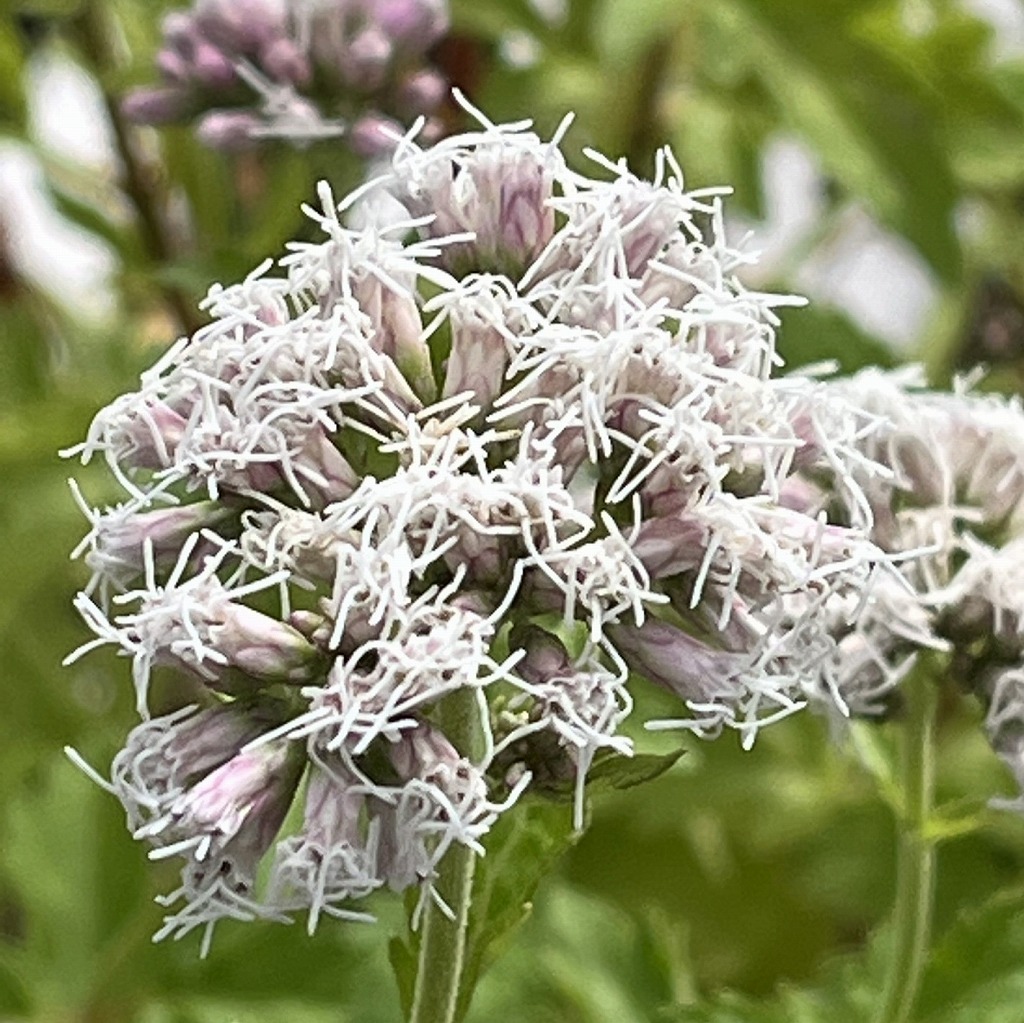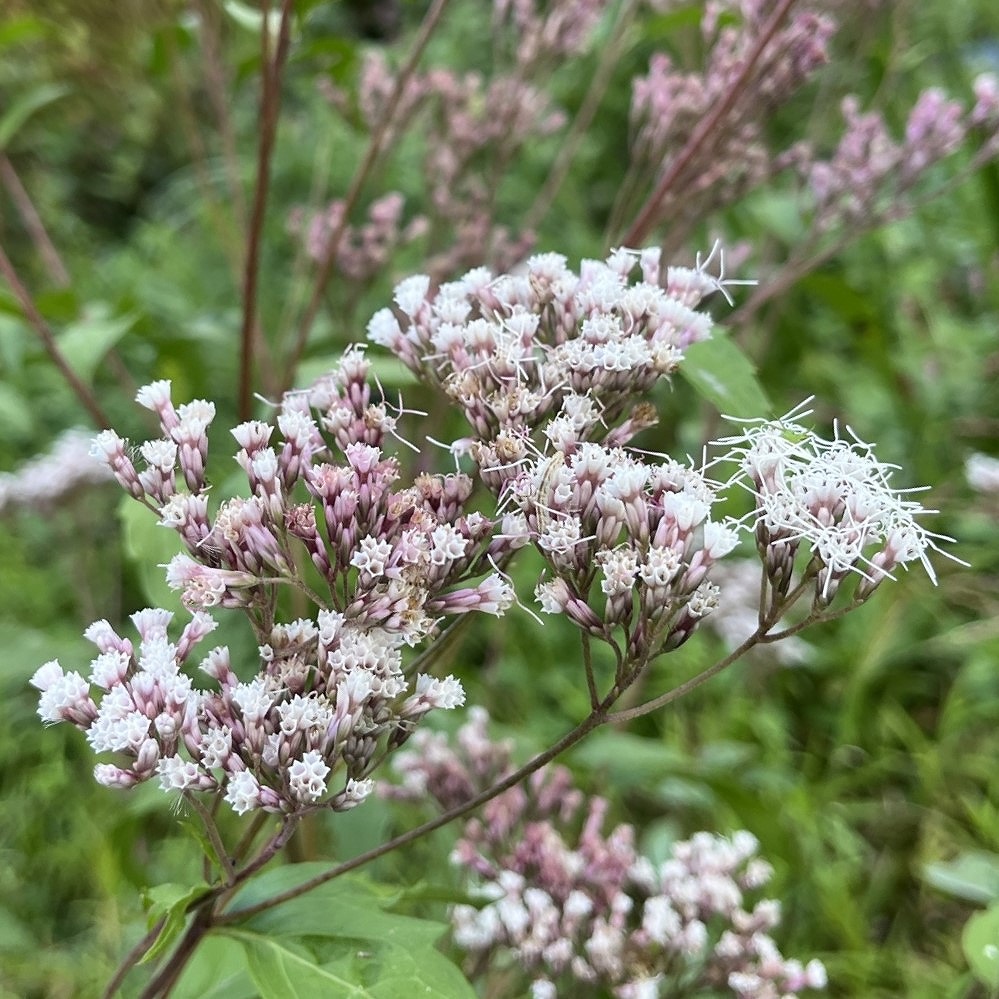フジバカマの名前の由来は、花の色が藤色を帯び、花の形が袴のようだから。茎葉を摘み取って少し乾かすと、桜餅のような匂いを放ちます。
The origin of the name “Mauve Hakama”, that is Thoroughwort in Japanese, is that the color of the flower is mauve and the shape of the flower looks like Hakama, which is Japanese traditional trousers. When the stems and leaves are picked and dried a little, they give off a Sakuramochi-like smell.
【仮名】フジバカマ
【和名】藤袴
【英名】Thoroughwort
【学名】Eupatorium japonicum
【誕生】09/ 28, 10/ 08, 11/ 06
【開花】08, 09, 10月
【花色】White, Pink, Purple



フジバカマ
フジバカマの来歴
フジバカマはキク科ヒヨドリバナ属の多年草です。日本では本州の関東地方から四国、九州まで、国外では朝鮮半島、中国に分布。かつては川原の土手など、日当たりがよく、湿ったところに群生していましたが、護岸整備などで衰退し、今は公園や庭園で園芸種が栽培されています。
フジバカマの名前
フジバカマの名前の由来は、花の色が藤色を帯び、花の形が袴のようだから。古くは「欄」(アララギ)と呼ばれて『日本書紀』にも記され、『万葉集』でも詠まれています。これは「蘭」と同義で、芳香がある植物の総称。中国では今でも「蘭草」「香草」「香水蘭」と呼ばれます。
フジバカマの姿形
フジバカマは根茎が這い広がり、茎が集まって立ち上がります。大きな葉は深く3つに裂けて対生。花は筒状で5つに裂け、雌しべは花柱が2つに裂けて長く伸び、雄しべは短く花筒内に収まります。筒状花が集まって平たい花冠を形成。花後の痩果は綿毛のついた種子を飛ばします。
フジバカマの近縁
フジバカマの在来種は花が白色。そして、山地や沢地で自然に生えているのは少し赤紫の白花で、外観の似ている近縁種です。山地に自生する「鵯花」、沢地に自生する「澤鵯」、その澤鵯と藤袴の交配種で茎が赤色の「澤藤袴」など。花色の濃い園芸種「小葉藤袴」も増えています。
フジバカマの利用
フジバカマは茎葉を摘み取って少し乾かすと桜餅のような匂いを放ちます。これは含有するクマリン配糖体が加水分解で芳香成分に変わるため。平安時代の女性たちは水に浸けて髪を洗いました。漢方では生薬「佩蘭」として健胃などに、民間療法では身近で手軽なアロマテラピーに。
Thoroughwort
Thoroughwort is a perennial herb belonging to the family Asteraceae. In Japan, it is distributed from the Kanto region of Honshu to Shikoku and Kyushu, and overseas it is distributed in the Korean Peninsula and China. It used to grow in colonies in sunny and moist places such as riverbanks, but it has declined due to the development of embankments, and now it is cultivated in parks and gardens.
The origin of the name “Mauve Hakama”, that is Thoroughwort in Japanese, is that the color of the flower is mauve and the shape of the flower looks like Hakama, which is Japanese traditional trousers. In the old days, it was called “Araragi” and was written in “Nihonshoki” and “Manyoshu”. This is synonymous with “orchid” and is a general term for plants with fragrance. In China, it is still called “orchid grass”, “fragrant grass”, and “perfume orchid”.
The rhizome of Thoroughwort spreads around, and the stems gather and stand up. The large leaves are deeply divided into three and opposite. The flower is tubular and split into 5, the pistil splits into 2 and elongates, and the stamen is short in the flower tube. Tubular flowers gather to form a flat corolla. Post-flowering achenes fly downy seeds.
The native species of Thoroughwort “Japonicum” has white flowers. The slightly reddish-purple white flowers with similar appearance that grow naturally in mountains and swamps are related species. “Makinoi” that grows wild in the mountains, “Arakianum” that grows wild in swampy areas, and “Hybrid” of Arakianum and Japonicum with red stems. The cultivar “Fortunei” with dark flowers is also increasing.
When the Thoroughwort stems and leaves are picked and dried a little, it smells like sakuramochi. This is because the contained coumarin glycosides are hydrolyzed into aromatic components. Women in the Heian period washed their hair with the water in which these stems and leaves were soaked. In Chinese medicine, it is used as a crude drug “Hairan” for stomach health, and in folk medicine, it is used as a familiar and easy aromatherapy.


